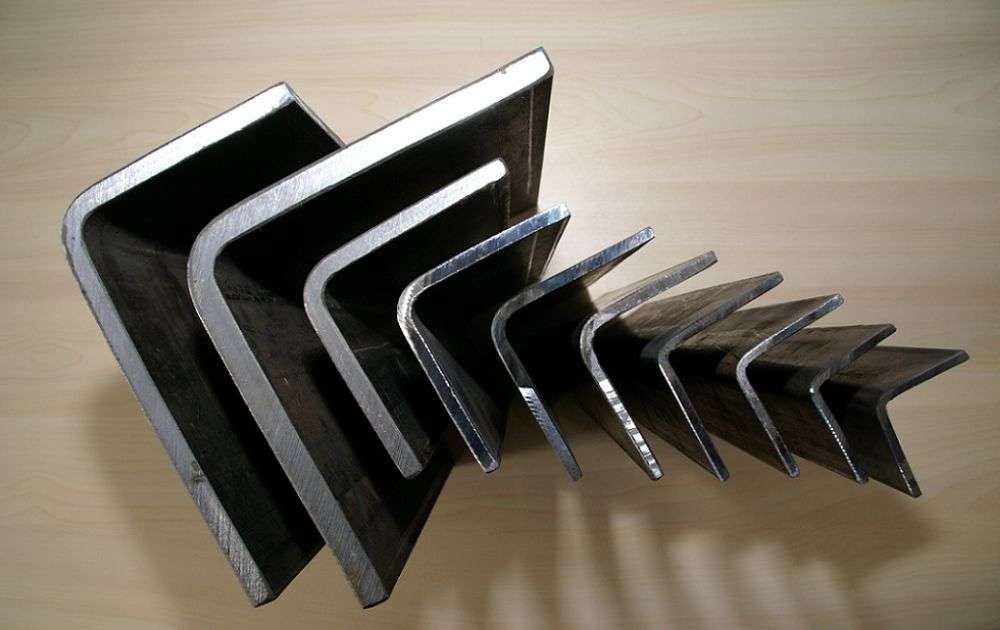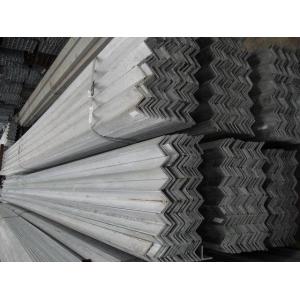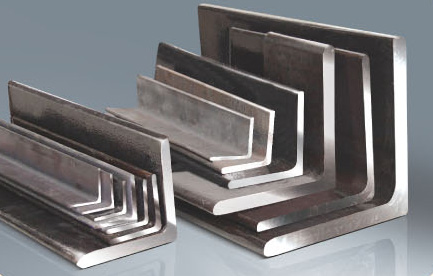Angle Steel for Ship, Vessels and Other Steel Structures Building ASTM A276
- Loading Port:
- Tianjin
- Payment Terms:
- TT OR LC
- Min Order Qty:
- 25 m.t.
- Supply Capability:
- 20000 m.t./month
OKorder Service Pledge
OKorder Financial Service
You Might Also Like
1)Standard:JIS AISI ASTM GB
2)Size: 25x25x3-100x100x10
3)Specification: as customers' requests.
Type | Stainless Steel Angle Bar |
Grade | AISI/SUS 201 202 301 302 303 304 304L 310 321 316 316L 410 420 430 |
Surface | Pickling, Sand Blasting |
Size | 25x25x3-100x100x10 |
Finished | Hot Rolled, Pickled, Sand Blasted |
Packing | Standard export packing, or as per customer's requests |
Payment | T/T, L/C, etc. |
Trade Terms | FOB/CFR/CIFetc. |
Stainless Steel Bar:
1.SS Angle Bar
*SS Equilateral Angle Bar
Specification:
Length: Standard length is 4m, 5m, 6m, length tolerance≤+ 40mm/pcs.
Shape: right angle tolerance is 2°
Surface: pickled or sand blasting.
2.SS Square Bar
*SS Cold Drawn Square Bar
*SS Hot Rolled & Pickled Square Bar
Specification:
Size: 12-180mm
Length:1-6mm
Surface: pickled&brushed
3.SS Hexagon Bar
*SS Cold Drawn Hexagon Bar
*SS Hot Rolled Hexagon Bar
Specification:
Diameter: 1.0-250mm
Length:1-6mm
Surface: bright
4.SS Flat Bar
*SS Hot Rolled & Pickled Flat Bar
*SS Drawn Flat Bar
Specification:
Thickness: from 3mm to 20mm
Width: from 19mm to 200mm
Length: 1-6Mm
Surface: pickled&brushed




OUR ADVANTAGES:
Our company is high quality supplier in China(mainland) with good reputation.
To develop the foreign markets, we provide customers high-quality stainless steel products with a competitive price, thoughtful after-sale service, excellent experience and import-export business skill.
Any questions, please feel free to contact with me!
- Q:Are steel angles suitable for agricultural applications?
- Yes, steel angles are suitable for agricultural applications. They are commonly used in the construction of agricultural buildings, fences, and equipment due to their strength, durability, and versatility. Steel angles provide stability and support, making them ideal for various agricultural tasks such as framing structures, reinforcing corners, or creating sturdy connections.
- Q:How do steel angles contribute to the overall stability of a building?
- Steel angles are an essential component of the overall stability of a building. They provide structural support and enhance the load-bearing capacity of the building framework. The angle shape of steel angles allows them to efficiently distribute and transfer the loads imposed on the structure, such as the weight of the floors, walls, and the roof, to the foundation. One of the key contributions of steel angles to the stability of a building is their ability to resist bending and buckling forces. The L-shaped design of steel angles helps to prevent the structural members from collapsing or deforming under heavy loads or external pressures. This resistance to bending and buckling ensures that the building remains structurally sound and stable, even in adverse conditions such as earthquakes or strong winds. Furthermore, steel angles are often used as bracing elements to provide lateral stability to the building. They are strategically placed in areas that require reinforcement against horizontal forces, such as wind or seismic activity. By connecting different structural components, steel angles help to distribute these lateral forces throughout the building, preventing excessive movement or deformation and maintaining the overall stability of the structure. In addition to their role in load-bearing and bracing, steel angles also contribute to the overall stability of a building through their durability and resistance to corrosion. Steel angles are typically made from high-strength steel, which offers excellent structural integrity and long-term reliability. This durability ensures that the building can withstand the test of time and remain stable throughout its lifespan. Overall, steel angles play a crucial role in enhancing the overall stability of a building. Their ability to resist bending and buckling forces, provide lateral stability, and their durability make them an integral part of the building's structural system. By effectively distributing and transferring loads, steel angles ensure that the building remains safe, secure, and stable, ensuring the well-being of its occupants and the longevity of the structure.
- Q:How do you prevent corrosion on steel angles?
- To prevent corrosion on steel angles, there are several preventive measures that can be taken: 1. Surface preparation: Before applying any protective coating, it is crucial to properly clean the steel angles to remove any dirt, rust, or other contaminants. This can be done through abrasive blasting, power tool cleaning, or chemical cleaning methods. 2. Protective coatings: Applying a protective coating on steel angles is one of the most effective ways to prevent corrosion. There are various types of coatings available, such as paint, epoxy, zinc-rich coatings, or galvanization. These coatings act as a barrier between the steel and the surrounding environment, preventing moisture and corrosive elements from coming into contact with the metal. 3. Cathodic protection: This method uses sacrificial metals or an impressed current to protect the steel angles from corrosion. Sacrificial metals, such as zinc or aluminum, are connected to the steel angles and corrode in place of the steel when exposed to corrosive elements. Impressed current systems use an external power source to provide a protective current to the steel, inhibiting corrosion. 4. Environmental control: Controlling the environment in which steel angles are installed can also help prevent corrosion. For example, reducing exposure to moisture, humidity, or corrosive chemicals can significantly extend the lifespan of the steel. This can be achieved by proper ventilation, ensuring proper drainage, or using protective coatings specifically designed for harsh environments. 5. Regular maintenance: Regular inspection and maintenance of steel angles are essential to identify any signs of corrosion early on. Any damaged or corroded areas should be repaired promptly to prevent further deterioration. Additionally, regular cleaning and reapplication of protective coatings can help maintain the integrity of the steel angles. By implementing a combination of these preventive measures, it is possible to significantly reduce the risk of corrosion on steel angles, prolong their lifespan, and maintain their structural integrity.
- Q:What are the different methods of surface galvanizing for steel angles?
- There are several different methods of surface galvanizing for steel angles, each with its own unique advantages and applications. Here are some of the most common methods: 1. Hot-dip galvanizing: This is the most widely used method of galvanizing steel angles. It involves immersing the steel angles in a bath of molten zinc, which forms a metallurgical bond with the surface of the steel. This process provides excellent corrosion protection and durability, making it suitable for a wide range of applications. 2. Electro-galvanizing: In this method, a thin layer of zinc is electrodeposited onto the surface of the steel angles. It is a more controlled process compared to hot-dip galvanizing and offers a smoother and more uniform coating. Electro-galvanizing is often used for decorative purposes or in applications where a thinner coating is sufficient. 3. Sherardizing: This method involves coating the steel angles with a mixture of zinc dust and a proprietary filler material, such as aluminum or iron powder. The coated angles are then heated in a furnace, causing the zinc to diffuse into the surface of the steel and form a durable alloy layer. Sherardizing provides excellent corrosion protection and is commonly used in applications where high resistance to wear and abrasion is required. 4. Mechanical galvanizing: Also known as centrifuge galvanizing, this method involves tumbling the steel angles in a drum or barrel with zinc powder and glass beads. The tumbling action causes the zinc powder to adhere to the surface of the steel angles, creating a protective coating. Mechanical galvanizing is often used for small or intricate parts that are difficult to galvanize by other methods. 5. Zinc-rich paint: Although not a traditional galvanizing method, zinc-rich paint can provide a similar level of corrosion protection. It involves applying a paint or coating that contains a high concentration of zinc particles to the surface of the steel angles. The zinc particles act as sacrificial anodes, corroding in place of the steel and providing protection against rust and corrosion. These are just a few of the different methods of surface galvanizing for steel angles. The choice of method depends on factors such as the desired level of corrosion protection, the specific application requirements, and cost considerations. It is important to consult with a galvanizing professional to determine the most suitable method for your specific needs.
- Q:What are the different welding methods used for steel angles?
- Steel angles can be welded using various methods, depending on factors such as steel thickness, joint type, and desired outcome. Below are some commonly used welding methods for steel angles: 1. Stick welding, also known as Shielded Metal Arc Welding (SMAW), involves manually feeding a consumable electrode coated in flux into the joint. The flux creates a protective shield around the weld pool. SMAW is versatile and suitable for different joint configurations and thicknesses. 2. Gas Metal Arc Welding (GMAW), commonly referred to as MIG or MAG welding, uses a continuously fed wire electrode through a welding gun. The electrode melts and joins the steel angles together, while a shielding gas protects the weld pool. GMAW is fast and suitable for thin to medium thickness steel angles. 3. Flux-Cored Arc Welding (FCAW) is similar to GMAW, but the wire electrode is filled with flux, eliminating the need for external shielding gas. FCAW is versatile, easy to use, and can be used in various positions. It is commonly used for thicker steel angles and in outdoor applications where wind may affect gas shielding. 4. Gas Tungsten Arc Welding (GTAW), also known as TIG welding, uses a non-consumable tungsten electrode to create an arc. A separate filler metal is manually added to the joint, while a shielding gas protects the weld pool. GTAW produces high-quality, precise welds and is commonly used for thinner steel angles or when aesthetics are important. 5. Submerged Arc Welding (SAW) involves continuously feeding a wire electrode into the joint while covering the weld area with granular flux. The flux acts as a protective medium and prevents atmospheric contamination. SAW is commonly used for thicker steel angles and in applications where high deposition rates are required. These are just a few of the commonly used welding methods for steel angles. Each method has its advantages and limitations, and the choice should be based on project requirements. Consulting with a qualified welding professional is important to determine the most suitable method for a specific application.
- Q:What is hot dip galvanized steel angle?
- Hot dip galvanized (galvanizing) also called hot dip galvanized and hot dip galvanizing: is an effective way of metal corrosion, mainly used for metal structure on the facilities of the industry.
- Q:How do you straighten a bent steel angle?
- To straighten a bent steel angle, you will need a few tools and equipment. Here's a step-by-step process to help you straighten the bent steel angle effectively: 1. Safety first: Ensure you are wearing appropriate protective gear, including gloves and safety goggles, to protect yourself from any potential hazards. 2. Assess the damage: Examine the bent steel angle to determine the severity of the bend. This will help you decide the best approach to straightening it. 3. Secure the angle: Place the bent steel angle securely in a bench vise or clamp, ensuring that it is firmly held in place. This will prevent any movement during the straightening process. 4. Apply heat (optional): If the bend is severe or the steel angle is hardened, you may need to apply heat to make it more malleable. Use a blowtorch or heat gun to heat the bent area until it becomes red-hot. 5. Use a hammer: With the bent steel angle secured, use a hammer to gently tap the bent area in the opposite direction of the bend. Start from the outer edges and work your way towards the center. Apply gradual force and avoid striking the steel angle with excessive force, as it may cause further damage. 6. Check progress: Periodically release the angle from the vise or clamp to inspect the progress. If necessary, reposition the steel angle to a different area in the vise to continue straightening. 7. Repeat if needed: Depending on the severity of the bend, you may need to repeat steps 4-6 multiple times to achieve the desired straightness. Be patient and take your time to ensure you do not overcorrect or cause any additional damage. 8. Test the angle: Once you believe the steel angle is straightened, carefully remove it from the vise or clamp and test its straightness. Place it on a flat surface and check if it lies completely flat without any visible bends or wobbling. Remember, this process requires precision and caution. If you're unsure or uncomfortable handling this task, it's best to consult a professional or experienced metalworker who can assist you in straightening the bent steel angle safely and effectively.
- Q:What is the minimum length of a steel angle?
- The minimum length of a steel angle can vary depending on the specific requirements and applications. Steel angles are typically available in standard lengths ranging from 20 feet to 40 feet. However, it is possible to cut steel angles to shorter lengths if needed. The minimum length of a steel angle would ultimately depend on factors such as the project specifications, structural requirements, and the supplier's capabilities. It is recommended to consult with a steel supplier or a structural engineer to determine the minimum length needed for a specific application.
- Q:What is the maximum length for a steel angle?
- The maximum length of a steel angle can differ based on the angle's specific type and size, as well as the steel supplier's manufacturing capabilities. Typically, steel angles are offered in standard lengths spanning from 20 to 40 feet. However, longer lengths could be attainable via custom orders or specialized production methods. To ascertain the readily available or obtainable maximum length for a particular steel angle, it is advisable to seek guidance from a steel supplier or manufacturer.
- Q:How does the weight of a steel angle affect its load-bearing capacity?
- The weight of a steel angle does not directly affect its load-bearing capacity. The load-bearing capacity of a steel angle is determined by its dimensions, material strength, and design factors such as the shape and support conditions. However, a heavier steel angle may indicate a higher material density, which could potentially result in increased load-bearing capacity if all other factors remain constant.
1. Manufacturer Overview |
|
|---|---|
| Location | |
| Year Established | |
| Annual Output Value | |
| Main Markets | |
| Company Certifications | |
2. Manufacturer Certificates |
|
|---|---|
| a) Certification Name | |
| Range | |
| Reference | |
| Validity Period | |
3. Manufacturer Capability |
|
|---|---|
| a)Trade Capacity | |
| Nearest Port | |
| Export Percentage | |
| No.of Employees in Trade Department | |
| Language Spoken: | |
| b)Factory Information | |
| Factory Size: | |
| No. of Production Lines | |
| Contract Manufacturing | |
| Product Price Range | |
Send your message to us
Angle Steel for Ship, Vessels and Other Steel Structures Building ASTM A276
- Loading Port:
- Tianjin
- Payment Terms:
- TT OR LC
- Min Order Qty:
- 25 m.t.
- Supply Capability:
- 20000 m.t./month
OKorder Service Pledge
OKorder Financial Service
Similar products
New products
Hot products
Related keywords




























